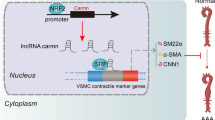Abstract
Recent evidence supports a role of Toll-like receptor (TLR) signaling in the development of atherosclerotic lesions. It was confirmed that the presence of functional TLR4 promotes a proinflammatory phenotype and proliferation of vascular smooth muscle cells (VSMCs). Here we tested whether designed TLR4 small interfering RNAs (TLR4 siRNAs) is capable of inducing TLR4 deficient and simultaneously regulating the expression of matrix metalloproteinase-9 (MMP-9) in human aortic smooth muscle cells (HASMCs). Human aortic smooth muscle cells were obtained from Cascade Biologics (Portland, USA). The siRNAs used in this study were chemically synthesized by Ambion, diluted in RNase free water at concentration of 2 μg/ml. The TLR4 siRNAs were complexed with LipofectamineTM2000 in transfection buffer. After 30 min incubation at room temperature, the complexes were added to the cells. Subsequent to 5 h incubation, cells were treated with 10 ng/ml LPS for 24 h. RT–PCR analysis was used to detect mRNA expression of GAPDH, TLR4 and MMP-9; Western blot analysis was used to examine GAPDH, TLR4 and MMP-9 protein expression. It was shown that all three designed TLR4 siRNAs inhibited the expression of TLR4 in HASMCs as compared to nontargeting siRNA. Notably, TLR4 siRNA-1 exhibited the strongest inhibition effect. Transfection of HASMCs with TLR4 siRNA-1 resulted in down-regulation of LPS-induced expression of MMP-9. It was concluded that TLR4 siRNA-transfected HASMCs were capable for regulating the expression of MMP-9, providing support for the rational design of siRNAs as atherosclerotic therapy.




Similar content being viewed by others
References
Medzhitov RM, Janeway CA Jr (1997) Innate immunity: the virtues of a nonclonal system of recognition. Cell 91:295
Sasu S, LaVerda D, Qureshi N, Golenbock DT, Beasley D (2001) Chlamydia pneumoniae and chlamydial heat shock protein 60 stimulate proliferation of human vascular smooth muscle cells via toll-like receptor 4 and p44/p42 mitogen-activated protein kinase activation. Circ Res 89:244–250
Hongli Li, Ying He, Zhang Jianjun, Sun Shuhan, Sun Baogui (2007) Lipopolysaccharide regulates toll-like receptor 4 expression in human aortic smooth muscle cells. Cell Biol Int 31:831–835
Lin SJ, Lee IT, Chen YH, Lin FY, Sheu LM, Ku HH, Shiao MS, Chen JW, Chen YL (2007) Salvianolic acid B attenuates MMP-2 and MMP-9 expression in vivo in apolipoprotein-E-deficient mouse aorta and in vitro in LPS-treated human aortic smooth muscle cells. J Cell Biochem 100(2):372–384
Hongli Li, Sun Baogui (2007) Toll-like receptor 4 in atherosclerosis. J Cell Mol Med 11(1):88–95
Cho A, Reidy MA (2002) Matrix metalloproteinase-9 is necessary for the regulation of smooth muscle cell replication and migration after arterial injury. Circ Res 91:845–851
Michelsen KS, Wong MH, Shah PK, Zhang W, Yano J, Doherty TM, Akira S, Rajavashisth TB, Arditi M (2004) Lack of Toll-like receptor 4 or myeloid differentiation factor 88 reduces atherosclerosis and alters plaque phenotype in mice deficient in apolipoprotein E. Proc Natl Acad Sci USA 101:10679
Abe K, Ikeda T, Wake K, Sato T, Sato T, Inoue H (2008) Glycyrrhizin prevents of lipopolysaccharide/D-galactosamine-induced liver injury through down-regulation of matrix metalloproteinase-9 in mice. J Pharm Pharmacol 60(1):91–97
Pagenstecher A, Stalder AK, Kincaid CL (2000) Regulation of matrix metalloproteinases and their inhibitor genes in lipopolysaccharide-induced endotoxemia in mice. Am J Pathol 157:197–210
Watari M, Watari H, Nachamkin I, Strauss JF (2000) Lipopolysaccharide induces expression of genes encoding pro-inflammatory cytokines and the elastindegrading enzyme, cathepsin S, in human cervical smooth-muscle cells. J Soc Gynecol Invest 7:190–198
Ogawa M, Suzuki J, Hishikari K, Takayama K, Tanaka H, Isobe M (2008) Clarithromycin attenuates acute and chronic rejection via matrix metalloproteinase suppression in murine cardiac transplantation. J Am Coll Cardiol 51(20):1977–1985
Fiotti N, Altamura N, Fisicaro M, Carraro N, Adovasio R, Sarra VM, Uxa L, Guarnieri G, Baxter BT, Giansante C (2005) MMP-9 microsatellite polymorphism: association with the progression of intima-media thickening and constrictive remodeling of carotid atherosclerotic plaques. Atherosclerosis 182(2):287–292
Acknowledgments
The research was supported by Shanghai Rising-Star Program (08QA14041 grant).
Author information
Authors and Affiliations
Corresponding author
Additional information
Hao Xu Contribute equally to the first author.
Rights and permissions
About this article
Cite this article
Li, H., Xu, H. & Liu, S. Toll-like receptors 4 induces expression of matrix metalloproteinase-9 in human aortic smooth muscle cells. Mol Biol Rep 38, 1419–1423 (2011). https://doi.org/10.1007/s11033-010-0246-4
Received:
Accepted:
Published:
Issue Date:
DOI: https://doi.org/10.1007/s11033-010-0246-4




